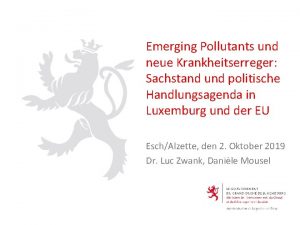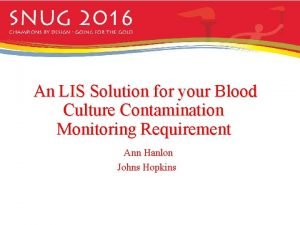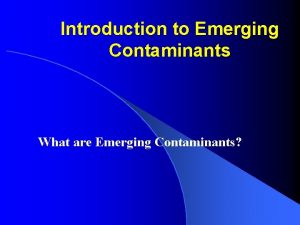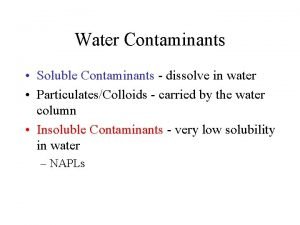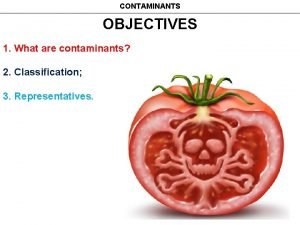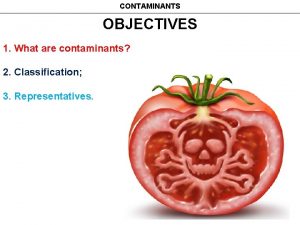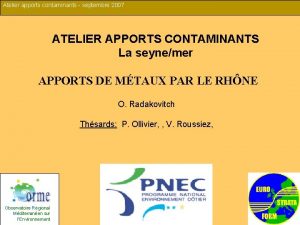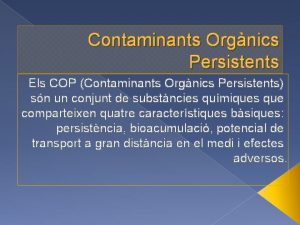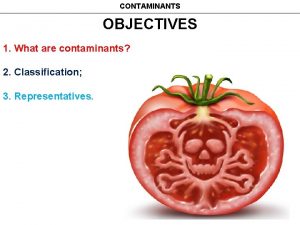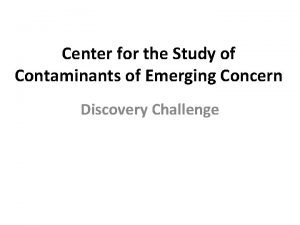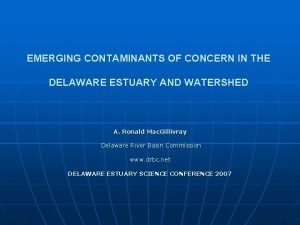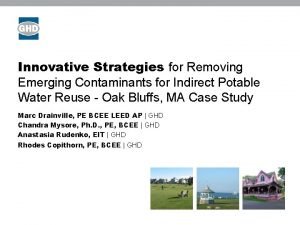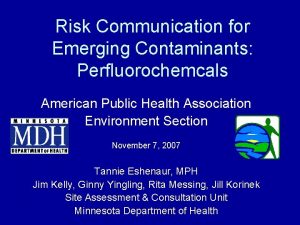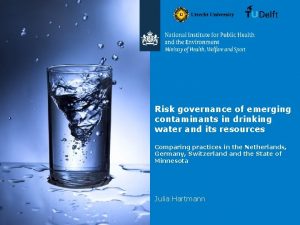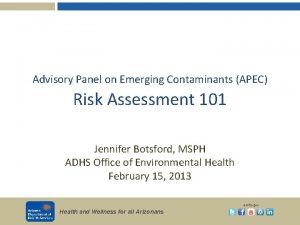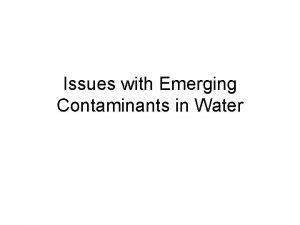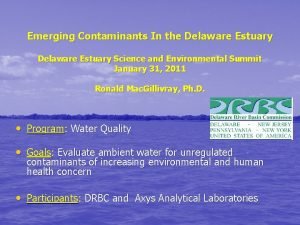Emerging Contaminants https www normannetwork net Emerging environmental





























- Slides: 29

Emerging Contaminants https: //www. norman-network. net Emerging environmental substances are not necessarily new chemicals. They are substances that have often long been present in the environment but whose presence and significance are only now being elucidated. "Emerging substances" can be defined as substances that have been detected in the environment, but which are currently not included in routine monitoring programmes at EU level and whose fate behaviour and (eco)toxicological effects are not well understood.

"Emerging pollutants" can be defined as pollutants that are currently not included in routine monitoring programmes at the European level and which may be candidates for future regulation, depending on research on their (eco)toxicity, potential health effects and public perception and on monitoring data regarding their occurrence in the various environmental compartments. Contaminant: any physical, chemical, biological, or radiological substance or matter that has an adverse effect on air, water, or soil.

Examples from the LIST OF EMERGING SUBSTANCES are surfactants, flame retardants, pharmaceuticals and personal care products, gasoline additives and their degradation products, biocides, polar pesticides and their degradation products and various proven or suspected endocrine disrupting compounds (EDCs).

Emerging contaminants algal toxins, antifoaming and complexing agents, antioxidants, detergents, disinfection byproducts, plasticizers, flame retardants, fragrances, gasoline additives, nanoparticles, perfluoroalkylated substances, personal care products, pharmaceuticals, pesticides, anticorrosives

Wastewater treatment Plants WWTPs

Drinking water Treatment DWT Industrial water Industry Drinking water Households Direct discharge Surface Waters (Rivers, lagoon) ct re Di dis ch ge ar WWTP Animal farming Soil Groundwater Agriculture le ac hi ng Landfill Wastewater treatment Plants WWTPs


Inadequate wastewater treatment, excessive use of pesticides or hospital wastewater discharges are important causes of surface water pollution by ECs’ transformation through DWT processes can lead to compounds which may be more toxic, persistent and less biodegradable than their predecessors

The most important environmental effects of EPs refer to: bioaccumulation and biomagnification, persistency, toxicity, endocrine disruption potential, carcinogenic effects, mutagenic and teratogenic effects A teratogen is an agent that can disturb the development of the embryo or fetus. Teratogens halt the pregnancy or produce a congenital malformation (a birth defect). Classes of teratogens include radiation, maternal infections, chemicals, and drugs.

Some ECs can be harmful for both humans and aquatic organisms, with endocrine disturbing effects, estrogenic or hormone disruption, fetal malformation, or even DNA damages










Adsorbents used for removal of emerging contaminants Activated carbon- higher sorption capacity, low price, low recovery Some papers of activated carbons should be classified as biochar Biochar- lower sorption capacity, low price, medium recovery Some papers of biochar should be classified as activated carbon Carbon nanotubes- high sorption capacity, High price, medium to high recovery Graphene- medium sorption capacity, high price, medium to high recovery

Graphene

Graphene Oxide

Reduced graphene oxide

Armchair CNT Zig-zag CNT

Activated Carbon

Synthesis of Mesoporous carbon used as adsorbent for Removing Emerging Contaminants.

Mesoporous carbons also are efficient adsorbents for removal of emerging contaminants have good to high sorption capacity and good recovery. However, the process of production of these carbon materials is expensive, limiting its large scale implementation.

All carbon adsorbents are the most eficient materials for Sorption of organic molecules due to the mechanism of Interaction. All other inorganic materials such as clays, Silica, rocks, will present lower sorption capacity.

 Grundwasserreinigung emerging contaminants
Grundwasserreinigung emerging contaminants Common blood culture contaminants
Common blood culture contaminants Wireless health
Wireless health Achmed lach net
Achmed lach net Ado.net vb.net
Ado.net vb.net Prova seama 2021
Prova seama 2021 Sistema integrado de avaliação sia
Sistema integrado de avaliação sia Plagiarism in ict
Plagiarism in ict Http//sciencespot.net
Http//sciencespot.net Https //htwins.net/scale 2/
Https //htwins.net/scale 2/ Nyc doe cybershift
Nyc doe cybershift T. trimpe 2011 http //sciencespot.net/
T. trimpe 2011 http //sciencespot.net/ T trimpe 2006 http //sciencespot.net/ answer key
T trimpe 2006 http //sciencespot.net/ answer key • https://englishteststore.net/index.php…
• https://englishteststore.net/index.php… Https //www.slideshare.net mobile
Https //www.slideshare.net mobile Https://wordwall.net/resource
Https://wordwall.net/resource Https://ipv4hub.net/
Https://ipv4hub.net/ Https://management.core.windows.net/
Https://management.core.windows.net/ Ares greek god backstory
Ares greek god backstory Serengeti.inquiry
Serengeti.inquiry Https://www.verifyprolicense.net
Https://www.verifyprolicense.net T. trimpe 2010 http://sciencespot.net/
T. trimpe 2010 http://sciencespot.net/ Https wordwall
Https wordwall Cal saws
Cal saws Rusty keele
Rusty keele Https //www.slideshare.net
Https //www.slideshare.net Phun thuã´ìc khæ°ò truìng https:anhung.net
Phun thuã´ìc khæ°ò truìng https:anhung.net Https://wordwall.net/es/resource
Https://wordwall.net/es/resource Issues in borrowing slideshare
Issues in borrowing slideshare Avatars.mds
Avatars.mds
